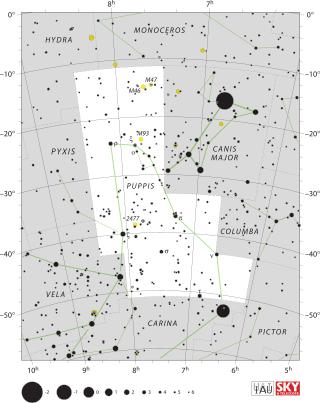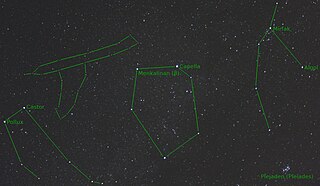
Caelum is a faint constellation in the southern sky, introduced in the 1750s by Nicolas Louis de Lacaille and counted among the 88 modern constellations. Its name means "chisel" in Latin, and it was formerly known as Caelum Sculptorium ; it is a rare word, unrelated to the far more common Latin caelum, meaning "sky", "heaven", or "atmosphere". It is the eighth-smallest constellation, and subtends a solid angle of around 0.038 steradians, just less than that of Corona Australis.

A Flamsteed designation is a combination of a number and constellation name that uniquely identifies most naked eye stars in the modern constellations visible from southern England. They are named for John Flamsteed who first used them while compiling his Historia Coelestis Britannica.

Johann Elert Bode was a German astronomer known for his reformulation and popularisation of the Titius–Bode law. Bode determined the orbit of Uranus and suggested the planet's name.

Pyxis is a small and faint constellation in the southern sky. Abbreviated from Pyxis Nautica, its name is Latin for a mariner's compass. Pyxis was introduced by Nicolas-Louis de Lacaille in the 18th century, and is counted among the 88 modern constellations.

Puppis is a constellation in the southern sky. Puppis, the Latin translation of "poop deck", was originally part of an over-large constellation Argo Navis, which centuries after its initial description, was divided into three parts, the other two being Carina, and Vela. Puppis is the largest of the three constellations in square degrees. It is one of the 88 modern constellations recognized by the International Astronomical Union.

Piscis Austrinus is a constellation in the southern celestial hemisphere. The name is Latin for "the southern fish", in contrast with the larger constellation Pisces, which represents a pair of fish. Before the 20th century, it was also known as Piscis Notius. Piscis Austrinus was one of the 48 constellations listed by the 2nd-century astronomer Ptolemy, and it remains one of the 88 modern constellations. The stars of the modern constellation Grus once formed the "tail" of Piscis Austrinus. In 1597, Petrus Plancius carved out a separate constellation and named it after the crane.
In astronomy, stars have a variety of different stellar designations and names, including catalogue designations, current and historical proper names, and foreign language names.

In electrical engineering and control theory, a Bode plot is a graph of the frequency response of a system. It is usually a combination of a Bode magnitude plot, expressing the magnitude of the frequency response, and a Bode phase plot, expressing the phase shift.

The Summer Triangle is an astronomical asterism in the northern celestial hemisphere. The defining vertices of this imaginary triangle are at Altair, Deneb, and Vega, each of which is the brightest star of its constellation. The greatest declination is +45° and lowest is +9° meaning the three can be seen from all places in the Northern Hemisphere and from the home of most people resident in the Southern Hemisphere. The two stars in Aquila and Cygnus represent the head of an eagle and tail of a swan that looks east inscribed into the triangle and forming the altitude of the triangle. Two small constellations, Sagitta and Vulpecula, lie between Aquila in the south of the triangle and Cygnus and Lyra to the north.

Lacerta is one of the 88 modern constellations defined by the International Astronomical Union. Its name is Latin for lizard. A small, faint constellation, it was defined in 1687 by the astronomer Johannes Hevelius. Its brightest stars form a "W" shape similar to that of Cassiopeia, and it is thus sometimes referred to as 'Little Cassiopeia'. It is located between Cygnus, Cassiopeia and Andromeda on the northern celestial sphere. The northern part lies on the Milky Way.

Messier 81 (also known as NGC 3031 or Bode's Galaxy) is a grand design spiral galaxy about 12 million light-years away in the constellation Ursa Major. It has a D25 isophotal diameter of 29.44 kiloparsecs (96,000 light-years). Because of its relative proximity to the Milky Way galaxy, large size, and active galactic nucleus (which harbors a 70 million M☉ supermassive black hole), Messier 81 has been studied extensively by professional astronomers. The galaxy's large size and relatively high brightness also makes it a popular target for amateur astronomers. In late February 2022, astronomers reported that M81 may be the source of FRB 20200120E, a repeating fast radio burst.
Messier 102 is a galaxy listed in the Messier Catalogue that cannot be unambiguously identified. Its original discoverer Pierre Méchain retracted his discovery two years after publication and said that it was a duplicate observation of Messier 101. Later historical evidence favors that M102 is actually the galaxy NGC 5866, although other galaxies have been suggested as possible identities. The National Aeronautics and Space Administration (NASA) considers it to be the same as NGC 5866.

Bode is a small crater located near the central region of the Moon, to the northwest of the joined craters Pallas and Murchison. It lies on a region of raised surface between the Mare Vaporum to the northeast, Sinus Aestuum to the west, and Sinus Medii to the southeast. The crater was named after German astronomer Johann Elert Bode.

Felis was a constellation created by French astronomer Jérôme Lalande in 1799. He chose the name partly because, as a cat lover, he felt sorry that there was not yet a cat among the constellations. It was between the constellations of Antlia and Hydra.

Quadrans Muralis was a constellation created by the French astronomer Jérôme Lalande in 1795. It depicted a wall-mounted quadrant with which he and his nephew Michel Lefrançois de Lalande had charted the celestial sphere, and was named Le Mural in the French atlas. It was between the constellations of Boötes and Draco, near the tail of Ursa Major, containing stars between β Bootis (Nekkar) and η Ursae Majoris (Alkaid).

Telescopium Herschelii, also formerly known as Tubus Hershelli Major, is a former constellation in the northern celestial hemisphere. Maximilian Hell established it in 1789 to honour Sir William Herschel's discovery of the planet Uranus. It fell out of use by the end of the 19th century. Psi2 Aurigae at apparent magnitude 4.8 was the constellation's brightest star.

Custos Messium — also known as “Vineyard Keeper," “Le Messier,” "Mietitore," and "Erndtehüter" — was a constellation created by Joseph Jérôme Lefrançois de Lalande to honor Charles Messier. It was introduced in 1775, and was located between the constellations Camelopardalis, Cassiopeia, Cepheus, and next to another subsequently abandoned constellation, Rangifer the Reindeer. Custos Messium is no longer recognized.

Officina Typographica was a constellation located east of Sirius and Canis Major, north of Puppis, and south of Monoceros. It was drawn up by Johann Bode and Joseph Jérôme de Lalande in 1798, and included in the former's star atlas Uranographia in 1801, honouring the printing press of Johannes Gutenberg. Lalande reported wanting to honour French and German discoveries in the same manner that Nicolas-Louis de Lacaille had done for his new constellations. It was called Buchdrucker-Werkstatt by Bode initially, and later Atelier Typographique in the 1825 work Urania's Mirror, Atelier de l’Imprimeur by Preyssinger in 1862 and Antlia Typographiae in 1888.

KT Eridani was a bright nova in the constellation Eridanus that produced an outburst in 2009. It was the first classical nova ever detected in that constellation. The nova was discovered at 12:52 UT on 25 November 2009 by K. Itagaki at Yamagata, Japan with a 21 cm patrol telescope. At the time of its discovery, it was a magnitude 8.1 object. The discovery occurred after the nova's peak brightness, but the All Sky Automated Survey system had detected the nova on three earlier occasions, allowing a more complete light curve to be produced. The peak magnitude, 5.4, was seen at 15:10 UT on 14 November 2009.

















